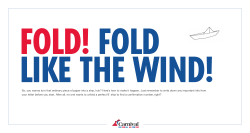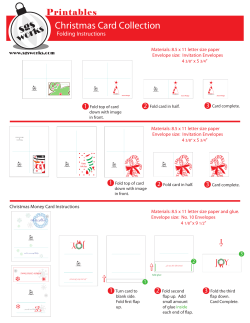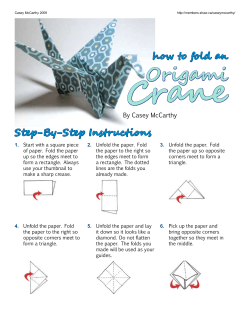
How To Fold An Origami Crane
How To Fold An Origami Crane While the crane is one of the more advanced origami designs, it can be mastered by most individuals. Repetition is the key to memorizing all the steps, and the best results come from carefully matching the corners and making the creases sharp. Begin with a square piece of paper -- ideally one side colored and the other plain. Place the colored side face up on the table. In all diagrams, the shaded part represents the colored side. 1. Fold diagonally to form a triangle. Be sure the points line up. Make all creases very sharp. You can even use your thumbnail. Unfold the paper. (important!) 2. Now fold the paper diagonally in the opposite direction, forming a new triangle. Unfold the paper and turn it over so the white side is up. The dotted lines in the diagram are creases you have already made. 3. Fold the paper in half to the ʺeastʺ to form a rectangle. Unfold the paper. 4. Fold the paper in half to the ʺnorthʺ to form a new rectangle. Unfold the rectangle, but donʹt flatten it out. Your paper will have the creases shown by the dotted lines in the figure on the right. 5. Bring all four corners of the paper together, one at a time. This will fold the paper into the flat square shown on the right. This square has an open end where all four corners of the paper come together. It also has two flaps on the right and two flaps on the left. 6. Lift the upper right flap, and fold in the direction of the arrow. Crease along line a-c. 7. Lift the upper left flap and fold in the direction of the arrow. Crease along the line a-b. 8. Lift the paper at point d (see the previous diagram) and fold down the triangle bdc. Crease along the line b-c. Undo the three folds you just made (steps 6, 7, and 8), and your paper will have the crease lines shown here (dotted lines). 9. Lift just the top layer of the paper at point a. Think of this as opening a frogʹs mouth. Open it up and back to line b-c. Crease the line b-c inside frogʹs mouth. Press on points b and c to reverse the folds along lines a-b and a-c. The trick is to get the paper to lie flat in the long diamond shape shown here. At first it will seem impossible. Have patience. 10.-13. Turn the paper over. Repeat Steps 6 to 9 on this side. When you have finished, your paper will look like this diamond with two ʺlegsʺ at the bottom. 14.&15. Taper the diamond at its legs by folding the top layer of each side in the direction of the arrows along lines a-f and a-e so that they meet at the center line. 16.&17. Flip the paper over. Repeat steps 14 and 15 on this side to complete the tapering of the two legs. 18. This figure has two skinny legs. Lift the upper flap at point f (be sure itʹs just the upper flap), and fold it over in the direction of the arrow - as if turning the page of a book. This is called a ʺbook foldʺ. Flip the entire figure over. 19. Repeat this ʺbook foldʺ (step 18) on this side. Be sure to fold over only the top ʺpageʺ. 20. This figure looks like a fox with two pointy ears at the top and a pointy nose at the bottom. Open the upper layer of the foxʹs mouth at point a, and crease it along line g-h so that foxʹs nose touches the top of the foxʹs ears. 21. Turn the figure over. Repeat step 20 on this side so that all four points touch. 22. Now for another ʺbook foldʺ. Lift the top layer (at point f), and fold it in the direction of the arrow. 23. Flip the entire figure over. Repeat the ʺbook foldʺ (step 22) on this side. 24.&25. There are two points, a and b, below the upper flap. Pull out each one, in the direction of the arrows, as far as shown. Press down along the base (at points x and y) to make them stay in place. 26. Take the end of one of the points, and bend it down to make the head of the crane. Using your thumbnail, reverse the crease in the head, and pinch it to form the beak. The other point becomes the tail. Open the body by blowing into the hole underneath the crane, and then gently pulling out the wings. And there it is!
© Copyright 2025





















